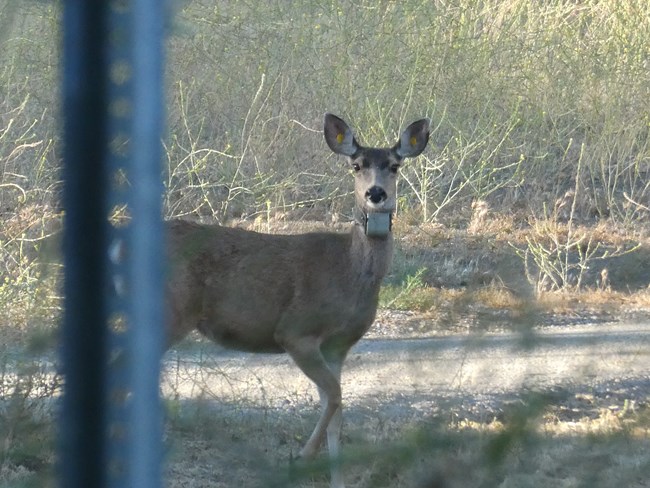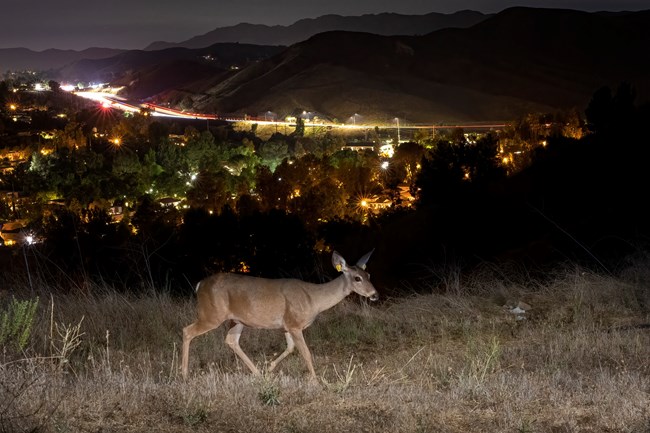
NPS/ Chris Bartel Mule Deer at Santa Monica Mountains National Recreation AreaMule deer (Odocoileus hemionus) are the largest herbivores at Santa Monica Mountains National Recreation Area. These beautiful animals are most often seen at dawn or dusk while out foraging. They eat a variety of grasses, herbs, shrubs, and acorns, depending on the season. Since they are ruminants (like cows), mule deer often spend the hottest part of the day resting in the shade and chewing their food to aid in digestion. Deer are social animals, although in the summer in the Santa Monica Mountains, female mule deer with fawns tend to be more solitary, and then larger groups of both males (bucks) and females (does) form for the breeding season (rut) in the fall and into the winter. When startled, “mulies” move in a “pronk” or “stot”, an iconic gait characterized by leaps forward where all four feet leave and then hit the ground in unison. Deer in the Santa Monica Mountains are slightly smaller than mule deer in other parts of the west, with does weighing ~120lbs and bucks weighing 150-170lbs. Why study mule deer?Mule deer occur throughout western North America and northwestern Mexico in a variety of habitats, including chaparral, oak woodlands, alpine forests, deserts, and grasslands. However, they have been little studied in highly developed areas or urban areas. Further, mule deer are an economically and ecologically important species in the west, but populations appear to be declining. Mule deer in the Santa Monica Mountains face a variety of challenges, including loss and fragmentation of habitat by roadways and development. They also contend with frequent fires, drought, and increasingly hot and dry summers that change availability of forage. Along with predation from mountain lions (Puma concolor), vehicle collisions are a main source of mortality. Studying deer in a landscape that is so heavily impacted by people is an opportunity to identify strategies for managing mule deer both in Southern California and across their range. In Santa Monica Mountains National Recreation Area, mule deer are important not only because of their role as herbivores that help shape plant life, but also because they are the main prey for mountain lions. Understanding the ecology of deer in the Santa Monica Mountains can give more insights into how mountain lions are using this landscape for hunting. 
NPS/Johanna Turner Our researchThe purpose of our research is to learn about the ecology of the mule deer that live at Santa Monica Mountains National Recreation Area, including how large their home ranges are, what habitats they prefer to use, how they are impacted by changing seasons, and how they respond to fire. We also want to understand how they avoid their predators (mountain lions) and how neighborhoods or recreating humans influence their behavior. Finally, we are also studying their connectivity and how they respond to major roads and different types of crossing structures. To study mule deer, biologists from The National Park Service collaborate with researchers from the University of California, Davis and University of Nebraska-Lincoln, and biologists from the California Department of Fish and Wildlife to capture deer and deploy GPS tags. Mule deer are captured using traps or chemical immobilization with darts. Each captured doe receives a GPS collar, ear tags, and is assessed for health. The bucks are given solar-powered GPS ear tags. The GPS collars/ear tags collect location data every 1-2 hours that are used to learn about home ranges, habitat use, foraging, movement, population density, and survival of mule deer across Santa Monica Mountains National Recreation Area. Each collar weighs about 1.5 lbs, which is less than 2% of the deer’s body weight and is roughly equivalent to the weight of a pair of shoes for an adult human. The collars are fitted to be comfortable yet secure and automatically fall off after a year and a half. Early findings from this research suggest that female mule deer in the Santa Monica Mountains have small home ranges (generally less than 1 square kilometer!) and their home ranges are smaller when the deer live closer to people. Mule deer in the Santa Monica Mountains are non-migratory but shift their home ranges seasonally, meaning they occupy slightly different parts of the landscape in winter as compared to summer, perhaps to track shifting resources.
Who are some of the study animals?I-405 Project: D1-D6Studied 2017-2018, these six does lived near the Sepulveda Overpass and were part of a study on how the I-405 impacts wildlife movement and connectivity of populations. They are the most urban deer we have studied.
Liberty Canyon Project: D7-9, D16, D18Monitoring of deer at Liberty Canyon began in 2020 and is on-going. This study will provide information on the movement of deer (and other wildlife) before, during, and after the construction of the Wallis Annenberg Wildlife Overpass over the 101 Freeway. D18 is a favorite from the study- while she lives on the south side of the 101 Freeway, she has occasionally used Liberty Canyon Road to go under the 101 for a little weekend get-away on the north side of the freeway! D7 and D9 were eaten by mountain lions that were collared as part of NPS research, providing valuable information on predator-prey interactions. SAMO Deer Project: D10-15, D17, D19-D31, D35-D39Monitoring of deer throughout the Santa Monica Mountains began in 2021. Several of these deer live very close to people, providing information about the way that urban areas impact deer habitat use, movement, and responses to predators. Additionally, these deer are revealing information about how deer behave in response to recovery from the Woolsey Fire. The SAMO deer live at Topanga Canyon, King Gillette and Diamond X Ranches, Malibu Creek State Park, Paramount Ranch, and Rancho Sierra Vista/Satwiwa. At Malibu Creek, people often see D35 and D37, two does who sometimes spend time together and may be related. At Topanga Canyon, keep an eye out for D39, who spends time around Trippet Ranch. Rocky Peak Project: D32-D34Research on wildlife movement relative to the 118 Freeway began in 2021 to help inform roadway crossing projects. Monitoring of deer began in 2023. A highlight of the study is D32, a doe who lives at Santa Susana State Park. Conejo ProjectIn fall of 2023, monitoring began on wildlife around the Conejo Grade. Deer are one of many species that will be studied to assess wildlife movement relative to this busy section of the 101 Freeway. |
Last updated: February 6, 2024
